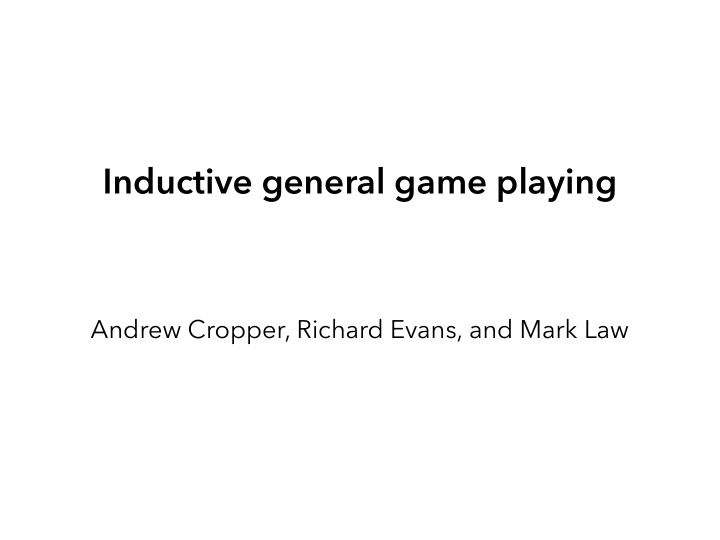



Inductive general game playing Andrew Cropper, Richard Evans, and Mark Law
Learning game rules Andrew Cropper, Richard Evans, and Mark Law
General game playing competition
Game description language • initial game state • legal moves • how moves update the game state • how the game terminates
Game description language ( succ 0 1) ( succ 1 2) ( succ 2 3) ( beats scissors paper) ( beats paper stone) ( beats stone scissors) (<= ( next ( step ?n)) ( true ( step ?m)) ( succ ?m ?n)) (<= ( next ( score ?p ?n)) ( true ( score ?p ?n)) ( draws ?p)) (<= ( next ( score ?p ?n)) ( true ( score ?p ?n)) ( loses ?p)) (<= ( next ( score ?p ?n)) ( true ( score ?p ?n2)) ( succ ?n2 ?n) ( wins ?p)) (<= ( draws ?p) ( does ?p ?a) ( does ?q ?a) ( distinct ?p ?q)) (<= ( wins ?p) ( does ?p ?a1) ( does ?q ?a2) ( distinct ?p ?q) ( beats ?a1 ?a2)) (<= ( loses ?p) ( does ?p ?a1) ( does ?q ?a2) ( distinct ?p ?q) ( beats ?a2 ?a1))
Our problem Learn rules from observations • goal • legal • next • terminal
Capablanca
Why? Many diverse games New games each year
Why? Independent language Not hand-crafted by the system designer Cannot predefine the perfect language bias Focus on the problem, not the representation
Why? Hard problems?
Rock, paper, scissors % BK beats(paper,stone). beats(scissors,paper). beats(stone,scissors). player(p1). % E+ player(p2). next_step(1). succ(0,1). succ(1,2). % E- succ(2,3). next_step(0). does(p1,stone). next_step(2). does(p2,paper). next_step(3). true_score(p1,0). true_score(p2,0). true_step(0).
Rock, paper, scissors next_step(N):- true_step(M), succ(M,N).
Rock, paper, scissors % BK beats(paper,stone). beats(scissors,paper). % E+ beats(stone,scissors). next_score(p1,0). player(p1). next_score(p2,1). player(p2). succ(0,1). % E- succ(1,2). next_score(p2,0). succ(2,3). next_score(p1,1). does(p1,stone). next_score(p1,2). does(p2,paper). next_score(p2,2). true_score(p1,0). next_score(p1,3). true_score(p2,0). next_score(p2,3). true_step(0).
Rock, paper, scissors draws(P):- does(P,A), next_score(P,N):- does(Q,A), true_score(P,N), distinct(P,Q). draws(P). loses(P):- next_score(P,N):- does(P,A1), true_score(P,N), does(Q,A2), loses(P). distinct(P,Q), next_score(P,N2):- beats(A2,A1). true_score(P,N1), wins(P):- succ(N2,N1), does(P,A1), wins(P). does(Q,A2), distinct(P,Q), beats(A1,A2).
Fizzbuzz BK divisible(12,1). less_than(0,1). divisible(12,2). less_than(0,2). ... ... divisible(12,12). less_than(30, 31). input_say(player,1). minus(1,1,0). input_say(player,2). minus(2,1,1). ... ... input_say(player,30). minus(31,31,0). input_say(player,fizz). positive_int(1). input_say(player,buzz). positive_int(2). input_say(player,fizzbuzz). ... role(player). positive_int(31). int(0). succ(0,1). int(1). succ(0,2). ... ... int(31). succ(30,31).
Fizzbuzz legal % BK true_count(9). true_success(6). % E+ legal_say(player,9) legal_say(player,buzz) legal_say(player,fizz) legal_say(player,fizzbuzz) % E- legal_say(player,0). legal_say(player,1). ... legal_say(player,8). legal_say(player,10). ... legal_say(player,31).
Fizzbuzz legal % BK % Hypothesis true_count(9). legal_say(player,N):- true_success(6). true_count(N). legal_say(player,fizz). % E+ legal_say(player,buzz). legal_say(player,9) legal_say(player,fizzbuzz). legal_say(player,buzz) legal_say(player,fizz) legal_say(player,fizzbuzz) % E- legal_say(player,0). legal_say(player,1). ... legal_say(player,8). legal_say(player,10). ... legal_say(player,31).
Fizzbuzz next count % BK does_say(player,buzz). true_count(12). % E+ next_count(13). % E- next_count(0). next_count(1). ... next_count(12). next_count(14). ... next_count(31).
Fizzbuzz next count % hypothesis % BK next_count(After):- does_say(player,buzz). true_count(Before), true_count(12). succ(Before,after). % E+ next_count(13). % E- next_count(0). next_count(1). ... next_count(12). next_count(14). ... next_count(31).
Fizzbuzz next success % BK does_say(player,buzz). true_success(3). % E+ next_success(3). % E- next_success(0). next_success(1). next_success(2). next_success(4). ... next_success(31).
Fizzbuzz next success correct:- next_success(After):- true_count(N), correct, divisible(N,15), true_success(Before), does_player_say(fizzbuzz). succ(Before,After). correct:- true_count(N), next_success(A):- divisible(N,3), \+ correct, \+ divisible(N,5), true_success(A). does_player_say(fizz). correct:- correct:- true_count(N), true_count(N), divisible(N,5), \+ divisible(N,5), \+ divisible(N,3), \+ divisible(N,3), does_player_say(buzz). does_player_say(N).
Hard problems?
Balanced accuracy ba = (tp/p + tn/n)/2
Perfectly solved the percentage of tasks that an approach solves with 100% accuracy
Results
Results
Results balanced accuracy
Results perfectly solved
Aleph Outcome Performs well out of the box Tends to learn overly specific programs Why? Default parameters No predicate invention
Metagol Outcome Excels at small dyadic programs Terrible at everything else Why? All or nothing approach Insufficient metarules Cannot learn large programs
ILASP Outcome Needed a bespoke version Best system, but still struggles Why? Struggles with a big hypothesis space
Summary IGGP poses many challenges Systems struggle without perfect language bias
Limitations and future work More metrics More games More systems Better ILP systems
https://github.com/andrewcropper/iggp https://github.com/andrewcropper/mlj19-iggp
Recommend
More recommend